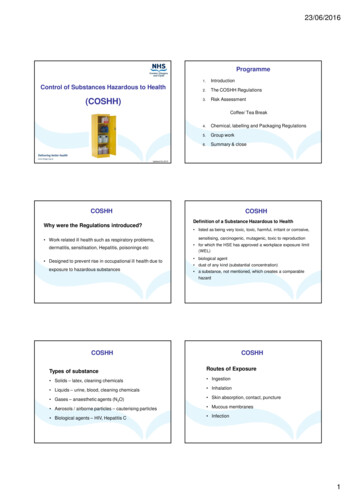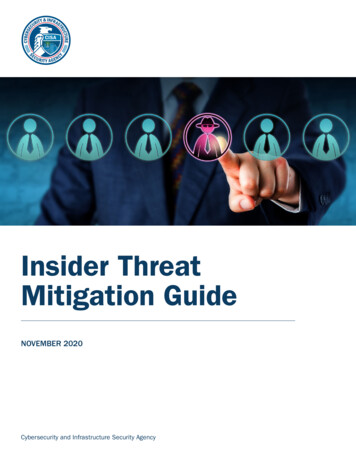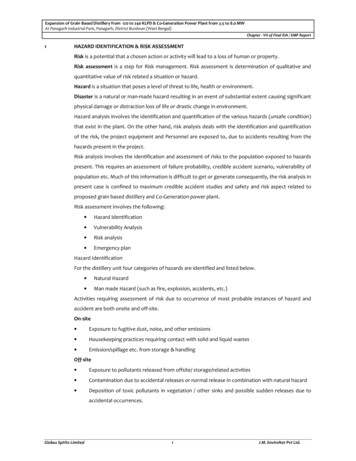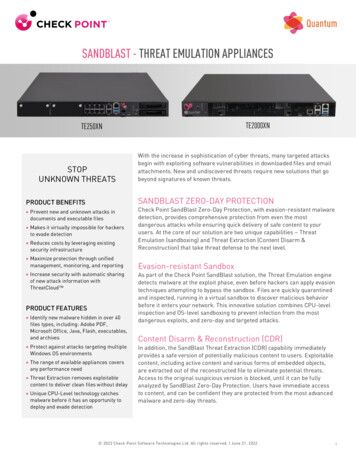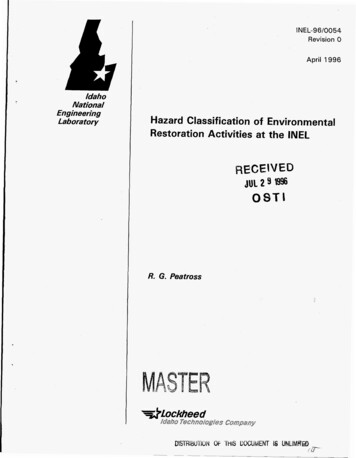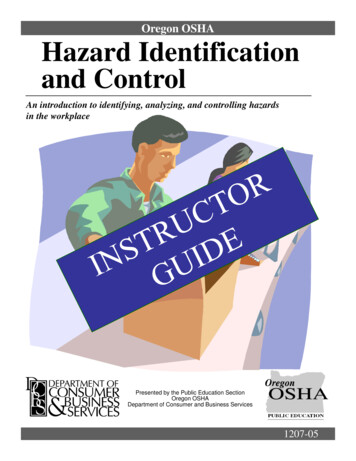
Transcription
UNIT 6. DEVELOPING THREAT/HAZARD-SPECIFIC ANNEXES
This page intentionally left blank.
Unit 6. Developing Threat/Hazard-Specific AnnexesUNIT INTRODUCTIONVisual 6.1Key PointsThis unit presents information on annexes that should be included in a school emergencyoperations plan (EOP) that focus on specific types of threats, hazards, and incidents.November 2013Multihazard Emergency Planning for Schools (G364)Student ManualPage 6.1
Unit 6. Developing Threat/Hazard-Specific AnnexesUNIT INTRODUCTIONVisual 6.2Key PointsThe unit objectives are to enable you to: State the elements included in threat/hazard-specific annexes.Develop or update threat/hazard-specific annexes.Both the importance of and the challenges faced in developing and implementing threat/hazardspecific procedures are great.Example #1: In March 2007, a deadly tornado hit a high school in Alabama. Officials at theschool had first planned on evacuating the school in response to the severe weather warnings.After learning of an approaching tornado, they decided to keep the students inside the school.Students moved to the interior of the school. Minutes later, a tornado struck the school, rippingoff the roof and collapsing walls. Eight students were killed. Although the school andgovernment officials faced heavy criticism from the community for the decision to remain at theschool, some said the death toll would have been far greater if the students had been outside,lining up for school buses, when the tornado hit.Example #2: A 43-year-old man, wearing a hooded jacket and carrying a backpack, walkedinto a high school with a group of students. He entered a classroom and took seven femalestudents hostage for several hours. Through hostage negotiations five students were releasedsafely. After several hours of no communication with the gunman, the tactical team forcefullyentered the classroom. One student escaped safely while the other was shot and died an hourlater.Page 6.2Multihazard Emergency Planning for Schools (G364)Student ManualNovember 2013
Unit 6. Developing Threat/Hazard-Specific AnnexesUNIT INTRODUCTIONVisual 6.2 (Continued)Although the school district had conducted an active shooter drill several weeks before theincident, they still identified several lessons learned based on the actual incident includingaddressing mental health needs, incorporating NIMS principles into the response, addressingcommunication interoperability, and considering student and staff access and functional needs.November 2013Multihazard Emergency Planning for Schools (G364)Student ManualPage 6.3
Unit 6. Developing Threat/Hazard-Specific AnnexesUNIT INTRODUCTIONVisual 6.3Key PointsEarlier units in this course described the first five steps in the CPG 101 planning process:forming the planning team, understanding the situation, determining goals and objectives, plandevelopment, and plan preparation, review, and approval.This unit continues with step 5 of the process, focusing on threat/hazard-specific annexes.Page 6.4Multihazard Emergency Planning for Schools (G364)Student ManualNovember 2013
Unit 6. Developing Threat/Hazard-Specific AnnexesDEVELOPING THREAT/HAZARD-SPECIFIC ANNEXESVisual 6.4Key PointsUnit 3 presented the importance of conducting assessments to identify threats and hazards inorder to develop a comprehensive school EOP. The process of developing threat/hazardspecific annexes builds on the information from the different school assessments.In order to properly develop threat/hazard-specific annexes, the planning team: Reviews the information gathered from the school’s threat and hazard assessments. Considers what information is already included in any functional annexes that have beendeveloped. Identifies any gaps in the information provided. Develops necessary threat/hazard-specific annexes.November 2013Multihazard Emergency Planning for Schools (G364)Student ManualPage 6.5
Unit 6. Developing Threat/Hazard-Specific AnnexesDEVELOPING THREAT/HAZARD-SPECIFIC ANNEXESVisual 6.5Key PointsIn developing threat- and hazard-specific annexes, the core planning team, working inconjunction with relevant subject-matter experts on the expanded team, should: Identify types of threat and hazard incidents that will require unique procedures within theschool EOP. Identify the title, goal, objective, and courses of action (including responsibilities,communication, and specific actions). Provide a brief summary of how the critical operational functions will be incorporated into thethreat- or hazard-specific annex. Test and refine the procedures. Approve and disseminate the procedures.Page 6.6Multihazard Emergency Planning for Schools (G364)Student ManualNovember 2013
Unit 6. Developing Threat/Hazard-Specific AnnexesDEVELOPING THREAT/HAZARD-SPECIFIC ANNEXESVisual 6.6Key PointsThe number and types of threat- and hazard-specific annexes included in the school EOPshould be based on the results of your security assessments and the identification of threatsand hazards of greatest concern.Not every threat or hazard requires an annex! Select those that present unique challenges or unique procedures, roles, orresponsibilities. Create a threat- or hazard-specific annex only if the given challenges arenot sufficiently addressed in the basic plan or functional annexes. Therefore, the schoolEOP may not include a great number of threat or hazard annexes.If there is a functional annex that applies to one of the threat or hazard annexes, the threator hazard annex should include it by reference. For example, if a course of action for a firehazard involves evacuation and there is an evacuation functional annex, the Fire ThreatAnnex would indicate “see Evacuation Annex” in the Fire Annex course of action section,rather than repeat the evacuation courses of action in the Fire Annex. Don’t repeat information presented in the basic plan or functional annexes. Repeatinginformation is not advisable for the following reasons:oSchool staff and students should learn and exercise simple procedures that apply to allthreats and hazards. The threat and hazard annexes should present only uniqueinformation.oRepeating procedures increases the possibility that there will be inconsistencies inprocedures that could lead to confusion during an incident.oThe school EOP becomes larger and more difficult for users to comprehend.November 2013Multihazard Emergency Planning for Schools (G364)Student ManualPage 6.7
Unit 6. Developing Threat/Hazard-Specific AnnexesDEVELOPING THREAT/HAZARD-SPECIFIC ANNEXESVisual 6.6 (Continued) Examples of threat/hazard-specific annexes in a school EOP include:oooooooHurricane/Severe StormEarthquakeTornadoHazardous Materials IncidentMass CasualtyActive ShooterPandemic/Disease Outbreak(Note: This is not a complete list. Planning teams must define annexes on the basis of theirhazard/threat and security assessment.)Page 6.8Multihazard Emergency Planning for Schools (G364)Student ManualNovember 2013
Unit 6. Developing Threat/Hazard-Specific AnnexesDEVELOPING THREAT/HAZARD-SPECIFIC ANNEXESVisual 6.7Key PointsWhen developing your threat/hazard-specific annexes: Summarize where and how hazards are likely to impact the school. The hazards may be:o Natural (e.g., earthquake, flood, hazardous weather, public health emergency).o Technological (e.g., infrastructure/utility disruption, radiological, or hazardous materialrelease).o Human-caused (e.g., criminal or violent behavior, intruder, demonstration, activeshooter, terrorism). Focus on the planning, mitigation, and response needs for a given hazard. This includesany provisions and protocols for warning the public and disseminating emergency publicinformation. Include:o Information on legal requirements as directed by specific local, State, and Federal laws.o Supporting documents as needed to clarify contents of the basic plan.For example, in the case of a terrorist incident the lead agency nationwide is the Federal Bureauof Investigation. There may be State laws governing response authorities for certain types ofincidents. It is important to consult legal counsel or research State laws when developingthreat/hazard-specific annexes.November 2013Multihazard Emergency Planning for Schools (G364)Student ManualPage 6.9
Unit 6. Developing Threat/Hazard-Specific AnnexesDEVELOPING THREAT/HAZARD-SPECIFIC ANNEXESVisual 6.8Key PointsNow that you know what should be included in a threat/hazard-specific annex, look at someexamples of hazards that you may want to include.While people may think of tornadoes or wildfires as natural hazards, pandemic disease such asinfluenza is also a natural hazard and you may want to include procedures in your school EOPto address the pandemic flu.Depending on the viral strain, the population may have little to no immunity to a flu virus. Inthese cases, influenza may: Cause serious illness.Spread easily from person to person.Sweep across the country and around the world in a very short time.Page 6.10Multihazard Emergency Planning for Schools (G364)Student ManualNovember 2013
Unit 6. Developing Threat/Hazard-Specific AnnexesDEVELOPING THREAT/HAZARD-SPECIFIC ANNEXESVisual 6.8 (Continued)The CDC advocates simple actions that everyone can do to stay healthy, including: Covering your nose and mouth with a tissue when you cough or sneeze.Washing your hands often with soap and water, especially after you cough or sneeze.Avoiding touching your eyes, nose, or mouth.Staying home if you get sick.The CDC also recommends that people with the flu should stay at home until 24 hours after thefever is gone. Other people in their household should also, to the degree possible, minimizeoutside contact during this time. State and local health agencies may have differentrecommendations, depending on the risk to local communities.A school should take these recommendations into account when developing the responseprocedures for a flu outbreak.The Centers for Disease Control and Prevention (CDC) has developed recommended actions totake for each school year. Check the CDC Web site (http://www.cdc.gov), search topic: schoolhealth.November 2013Multihazard Emergency Planning for Schools (G364)Student ManualPage 6.11
Unit 6. Developing Threat/Hazard-Specific AnnexesDEVELOPING THREAT/HAZARD-SPECIFIC ANNEXESVisual 6.9Key PointsSchools may also want to include a threat/hazard-specific annex on school violence. Schoolviolence: Can be directed at students or faculty/staff.Includes bullying, cyberbullying, slapping, punching, weapon use, and sexual assault.May involve one or more schools, as in gang violence and inter-school rivalries.Page 6.12Multihazard Emergency Planning for Schools (G364)Student ManualNovember 2013
Unit 6. Developing Threat/Hazard-Specific AnnexesDEVELOPING THREAT/HAZARD-SPECIFIC ANNEXESVisual 6.10Key PointsThe Sample School EOP includes threat/hazard-specific annexes related to natural (flood,pandemic), technological (hazardous materials), and human-caused (active shooter) threatsand hazards.November 2013Multihazard Emergency Planning for Schools (G364)Student ManualPage 6.13
Unit 6. Developing Threat/Hazard-Specific AnnexesPLAN REVIEW SESSIONVisual 6.11Key PointsPurpose: This activity will enable you to review and further develop your school EOP.Instructions: Working as a school team or individually:1. Review the threat/hazard-specific annexes in your school EOP, the sample plan (ifprovided), and the Threat/Hazard-Specific Annex Content Guide that follows.oAre any annexes repetitive or unnecessary?oDetermine if the threat/hazard-specific annexes include: The school’s specific concerns, capabilities, and resources. Responsibilities (principal’s actions, staff/faculty actions, etc.). Critical operational functions or procedures for responding to this hazard.2. Are there additional procedures and/or threat/hazard-specific annexes you need to develop?Page 6.14Multihazard Emergency Planning for Schools (G364)Student ManualNovember 2013
Unit 6. Developing Threat/Hazard-Specific AnnexesPLAN REVIEW SESSIONVisual 6.11 (Continued)3. Update your EOP. Remember that you do not need to repeat information containedelsewhere in the plan.Use your instructor and the Sample School EOP as resources!November 2013Multihazard Emergency Planning for Schools (G364)Student ManualPage 6.15
Unit 6. Developing Threat/Hazard-Specific AnnexesUNIT SUMMARYVisual 6.12Key PointsIn this unit, the following key points were presented:Threat/hazard-specific annexes: Build on threat, hazard, and vulnerability identification and assessments. Describe emergency response strategies for a specific threat, hazard, or incident. Provide information unique to that threat, hazard, or incident and should not repeatinformation contained elsewhere in the school EOP.Useful toolkit resources related to this unit are provided in the Threat/Hazard-SpecificProcedures section under Developing Plans and Procedures.Unit 7 describes considerations for training and exercising the procedures in the school EOP.Page 6.16Multihazard Emergency Planning for Schools (G364)Student ManualNovember 2013
o Human-caused (e.g., criminal or violent behavior, intruder, demonstration, active shooter, terrorism). Focus on the planning, mitigation, and r esponse needs for a given hazard. This includes any provisions and protocols for warning the public and disseminating emergency public information. Include: o Information on legal requirements as directed by specific local, State, and Federal .


